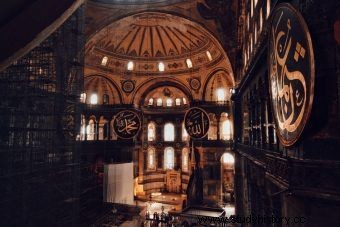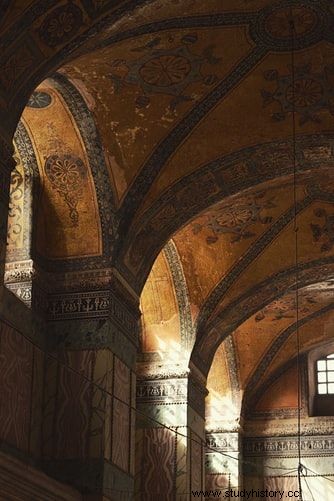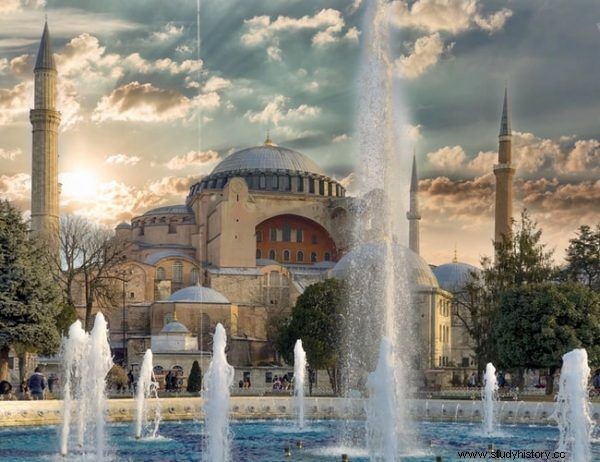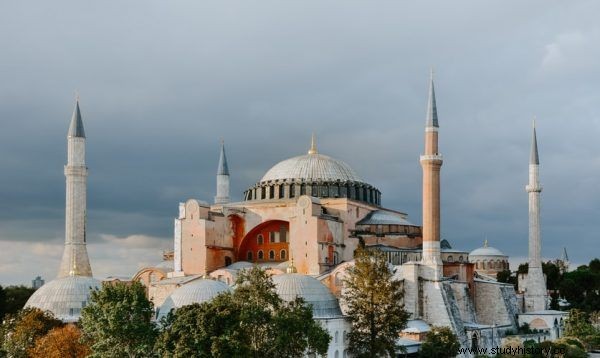Legend says that Emperor Justinian received the plans for the expansion of the temple, considered to be one of the most beautiful religious buildings of the first millennium AD, from a host of angels. But the story, as improbable as it is, may in some ways be true. Because Hagia Sophia is a truly divine work, a manifestation of changing styles in art and cultures, a union of great religions. Muslim or Christian? Who does it belong to? What secrets are stored in its walls?
"Glory to you, God, for allowing me to do such a work!" - this is how Justinian I the Great, a Byzantine emperor, and a saint of the Orthodox Church, was to summarize the completion of the most important stage of work on the temple.

Hagia Sophia is undoubtedly one of the most outstanding architectural monuments
Hagha Sophia was a symbolic jewel in the crown of a ruler of the Justinian dynasty, built in the historic center of modern Istanbul . Scholars are quite unanimous that it was during the times of the aforementioned ruler that the Byzantine Empire reached perhaps the greatest power - and in many different ways.
Imperial foundations of Justinian I the Great
Justinian set himself the goal of rebuilding the Roman Empire, the Roman Empire in all its territorial and political power. To this end, he also assumed the title of autocrator, exercising virtually absolute power, having no superior over himself. During his forty years of reign, he brought Byzantium to the height of its power, and his leadership is today one of the most important periods in the history of a forgotten empire. After all, it was Justinian I the Great who influenced, for example, the development of law, establishing the division into civil and criminal law. Finally, it was during his lifetime and on his initiative that the most important part of the temple known as Hagia Sophia was built.
Temple built over the centuries and museum heritage
"And we did not know whether we were on earth or in heaven ..." - these are the words of one of the emissaries of Prince Vladimir the Great from Kiev, which were written after his visit to the Church of God's Wisdom, Hagia Sophia. The temple is astonishing with its architectural form, an expression of various, changing influences in art. Even a sketchy cross-section allows you to visualize the enormous momentum of the structure. The layout of the sacred building was based on four mighty pillars placed on a square plan, as well as 107 columns that support the structure.

The original building was built as the Church of God's Wisdom
The huge nave - built with stone, concrete and marble - Muslim chandeliers with lamps for making wishes, extremely rich ornaments, and finally mosaic masterpieces - Saint John Chrysostom, John the Baptist, Mother of God or Pantocrator, in Christian iconography, Jesus Christ as the ruler and judge of the universe. Here is just a small excerpt from the art treasury. Because for nearly a hundred years, from 1934 to July 2020, the temple acted as a museum. This came after the fall of the Ottoman Empire, when Turkey became a secular republic. And so Mustafa Kemal Atatürk decided that the temple, which for nearly a thousand years has served as a holy place for Christians and for nearly half a century for Muslims, should finally be transformed into a temple of art.
We need to know that although the greatest contribution to the expansion of the Church of God's Wisdom is attributed to the aforementioned Justinian I the Great, the foundations for the construction of the first temple - the church basilica - were already laid by Constantine the Great in 326, and the first phase of work was completed in 360 by his son, Constantius II. In the walls of this unique building, historical beauty and secrets have been written.
A Stormy History - Mysticism, Wealth and Legends
The imperial foundations have survived to the present day, but in the meantime the temple was marked by disasters and destruction. The first religious structure existed until 404, when the wooden housing burnt down during the riots. Already in 415, another ruler - Emperor Theodosius II - ordered the rebuilding of the church, but during the uprising of Nika (532) - the Constantinople People's Uprising - the temple was again destroyed and rebuilt by Emperor Justinian. In later centuries, there were still earthquakes, which, however, did not destroy the beauty of Hagia Sophia.
According to one of the legends, Emperor Justinian I the Great was to obtain knowledge and inspiration in the preparation of the initial outline for the reconstruction of the temple during conversations with an angel. It is certainly true, however, that the temple is special, if only because of the parts from which the structure was built. C honor marble columns obtained from ancient cities in Syria and Anatolia, white, pink and yellow marble - from the islands of the Sea of Marmara, Afyon and North Africa respectively. Moreover, the whole is complemented by columns from the temple of Artemis in Ephesus, considered by the ancients to be one of the wonders of the world.

Hagia Sophia serves as a museum until July 2020
Miracles are inside. The outer vestibule is crowned with a vault covered entirely with golden mosaics, in the interior of the former basilica, mosaics with alleged images of seraphim, i.e. angelic guards, have been discovered. Anyway, the interior of the dome is also covered with a golden mosaic, and on the pendentives - a special type of triangular vault - the artists realized the figures of cherubim. In turn, crossing the central door leading to the nave, we come into contact with mysticism. As another legend says, the gates were made of wood supposedly from Noah's Ark.
In the following centuries, not only the cultural image of the epoch changed, but also the interior of the temple. When the Ottoman Turks captured the city in 1453, Sultan Mehmed II decided to transform Hagia Sophia into a mosque.
Muslims covered some of the Christian mosaics and added characteristic minarets. In the wonderful complex there is a cavernous library, mausoleums, as well as a sultan's lodge, a madrasah, or a Muslim theological school, and a fountain for ablution. It is worth noting that even today many eastern mosques are built on the model of the plans for this facility. Now Hagia Sophia has become a mosque again.
A church that became a mosque
Until July 24, 2020, the temple complex functioned as a huge museum. Now Turkish President Tayyip Recep Erdogan has signed a special decree formally transforming the Hagia Sophia museum into a Muslim mosque.
The concern about this decision was expressed by UNESCO representatives, explaining that it was interfering with the status of the World Heritage List.
Hagia Sophia is an architectural masterpiece and a unique testimony to the interaction between Europe and Asia over the centuries. Its status as a museum reflects the universal nature of its heritage and makes it a powerful symbol of dialogue
- Director General Audrey Azoulay said in a statement.

Hagia Sophia continues to delight today
One of the most beautiful and important religious buildings in the world, gaining a new religious dimension, may lose its universal splendor. Because Hagia Sophia is a truly divine work, a manifestation of changing styles in art and cultures, a union of great religions - a Christian church and a Muslim mosque, a symbol of an ambiguous history.
